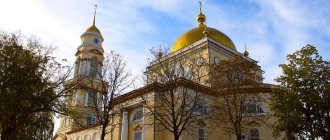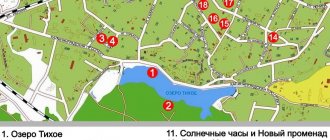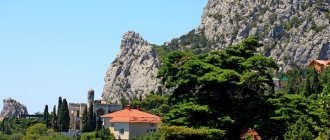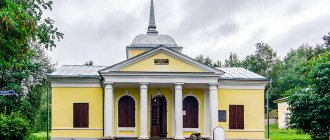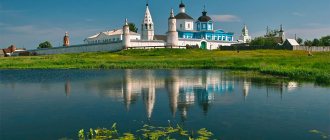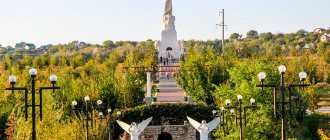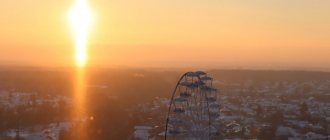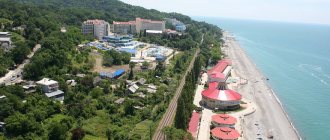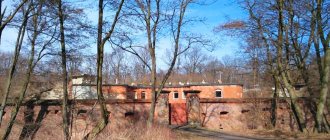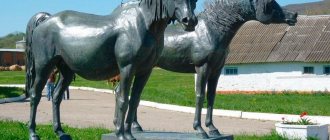The best attractions in the vicinity of Kaluga
Avchurino
Avchurino
Since August 30, 1960 it has been recognized as a monument of national significance. The estate, built in the Empire-Neo-Gothic style, is located not in Kaluga itself, but in the region, in the Ferzikovsky district.
Construction of the estate began in 1792, after the acquisition of the estate by Dmitry Markovich Poltoratsky. Famous architects of that century had a hand in the design of the estate: V.F. Andreevich, V.P. Stasov, Luigi Peli.
This estate is famous not so much for its outlandish architecture, but for its extensive library, for which Karamzin and Zhukovsky came here. In the spring of 2022, restoration work began on the estate.
Address: Kaluga region, Ferzikovsky district, Avchurino village, st. Central
Opening hours: you cannot go inside the estate due to restoration work; you can see from outside
Yachenskoye Reservoir
Yachenskoye Reservoir
In the west of Kaluga, at the mouth of the Yachenka River, a reservoir 2.5 km long overflowed. In some places, its width reaches 800 meters, and its maximum (recorded) depth is 7 m. For the recreation of city residents, this man-made water resource was created in 1980, before the international summer Olympics, which was held in Moscow.
Address: Yachenskoye Reservoir, Kaluga, Kaluga region.
Museum-diorama “Great Stand on the Ugra River”
Museum-diorama “Great Stand on the Ugra River”
The first and only museum in Russia whose exhibition is dedicated to the campaign of 1480. The initiative to create a historical museum came from the Kaluga Monastery of St. Tikhon's Hermitage. The museum was opened in 2014 on the territory of the monastery monastery.
The center of the exhibition is the canvas of battle painter Pavel Viktorovich Ryzhenko. Its length is 23.6 and its height is 6.7 meters.
Address: Tserkovnaya st., 1, village of Dvortsy
Opening hours: daily from 9:00 to 17:00
Entry cost: from 100 to 300 rubles
Official website: diorama-ugra.ru
Ethnographic park-museum "Ethnomir"
Ethnographic park-museum "Ethnomir"
The ethnoworld is a riot of colors and the absence of fuss. When people get here, they forget about stress by participating in master classes on painting, weaving, knitting, and weaving. Outdoor recreation, folk crafts, outdoor games help you return to a serene time - without stress and nervousness.
Here you can relax, because nothing threatens the child, unlike the courtyards of high-rise buildings. Ethnoworld with its ethnohotels is a real fairy tale for city residents.
Address: Kaluga region, Borovsky district, Petrovo village
Opening hours: daily, 09:00–21:00
Entry cost: the cost of participation in the programs varies, you can find out from the managers
Official website: ethnomir.ru
Ugra National Park
Ugra National Park
The main activities of the budgetary state park are aimed at preserving the nature of the region, protecting animals, and helping to increase the population of endangered species. In this protected area you can meet local forest inhabitants, who are helped to survive by museum staff.
From here tourists leave with souvenirs and books about wildlife. The main direction of the park is scientific research aimed at improving the environment.
Address: village Prigorodnoye lesnichestvo, 3a
Opening hours: Mon-Fri 09:00–16:30
Entry fee: paid
Official website: parkugra.ru
Yachenskoye Reservoir
The sun was setting. We decided to spend the evening near the Yachenskoye (Kaluga) reservoir.
Yachenskoye Reservoir VoClub facilities on the Yachenskoye Reservoir
Dam of the Yachen Reservoir
What to visit in Kaluga for free
Church of Cosmas and Damian
Church of Cosmas and Damian
The Kosmodamianovskaya church with wooden walls and a vault is mentioned in descriptions of 1626 and 1685 as the temple of St. Nicholas the Wonderworker, which is behind the benches, with the chapel of Cosmas and Damian. It stood on Bogoyavlenskaya Street until the fire in 1754. (Now this street is named after commander Kutuzov).
40 years after this event, a baroque church was built on the street now named Friedrich-Engels. It did not operate under the power of the Soviets. Since 1992, this building has again opened its doors to believers.
Despite the long-term oblivion, the ancient painting has been preserved in the church, which the parishioners are restoring with their own efforts for the glory of God.
Address: st. Friedrich Engelsa, 14A, Kaluga
Opening hours: daily
Entry fee: free
Holy Trinity Cathedral
Holy Trinity Cathedral
Its construction began in 1786 and was completed in 1808. But only in 1818 the decoration of the temple was completed. Bishop Anthony illuminated the temple on April 10, 1819, which coincided with Easter services.
Now services are held in this cathedral, and those who are simply interested in icon painting also visit it.
Address: Russia, Kaluga, Central City Park of Culture and Leisure
Opening hours: daily
Entry fee: free
Official website: sobor-kaluga.ru
Church of John the Baptist
Church of John the Baptist
Since 1960, the Church of John the Baptist has been on the list of architectural shrines. At the end of the 20th century, the building belonged to the College of Culture. In 1995, the Kaluga Baptist Church, according to an agreement, was transferred to the Orthodox Church. This decision was made to preserve the Russian shrine.
After 12 years, at the end of January 2007, the temple became the property of the Kaluga Regional Diocese.
Address: Moskovskaya st., 30, Kaluga
Opening hours: Mon-Fri 07:30–18:30; Sat, Sun 06:30–18:30
Entry fee: free
Official website: i-predtecha.ru
Church of the Intercession of the Blessed Virgin Mary “on the moat”
Church of the Intercession of the Blessed Virgin Mary “on the moat”
The name of the church partly comes from its location, directly above the ditch, which served as an obstacle for the enemy during the siege of the city wall. The first Kaluga Kremlin was made of wood. It was restored several times, literally being resurrected from the ashes.
After another fire, in the late 80s of the 17th century, it was decided to install a stone temple next to the wooden church.
During Soviet times, the temple served as an incubator and concert hall. In the 90s of the 20th century, it again became a full-fledged functioning temple.
Address: st. Marata, 4, Kaluga
Opening hours: daily, 08:00–20:00
Entry fee: free
Official website: sobory.ru/article/?object=00912
Cathedral of St. George "behind the horse"
Cathedral of St. George "behind the horse"
The temple got its name from its location. “Top” in the local dialect meant “ravine.” That is, this word indicates that the temple is located behind the ravine.
Orthodox operating city cathedral in Kaluga. Built in 2 years, in 1700-1701. It houses the shrine of the Kaluga diocese - the miraculous Kaluga Icon of the Mother of God.
Address: st. Baumana, 14, Kaluga
Opening hours: daily, 07:00–19:00
Entry fee: free
Official website: sobory.ru/article/?object=00909
Kazan nunnery
Kazan nunnery
The history of this monastery is lost in the mists of time. In the Kaluga diocese, until 1868, it was the only convent. With the onset of Soviet power, it was closed for many years. Only during perestroika did they begin to restore it, like many other religious institutions that had previously belonged to Christians.
Address: Monastyrsky lane, 1, Kaluga
Opening hours: Mon-Fri 09:00–18:00
Entry fee: free
Official website: spasnaugre.ru
Laurentian Monastery
Laurentian Monastery
In 1515, the Kaluga St. Lawrence Monastery was founded. At that time Kaluga was an independent principality. The Grand Duke of Moscow, John III, gave Kaluga as an inheritance to his fourth son - Prince Simeon of Kaluga. Only 31 years were measured by fate for the pious Simeon. (1487-1518).
In the ancient monastery of the city of Kaluga and the entire Kaluga land, the prince who took upon himself the fate of Christ for the sake of saving the holy fool is remembered in prayers.
Address: Shirokaya st., 49, Kaluga
Opening hours: daily
Entry fee: free
Official website: splavrenty.ru
Nikolo-Kozinskaya Church
Nikolo-Kozinskaya Church
The wooden church was first mentioned in the inventory of 1626 as “the Church of St. Nicholas the Wonderworker in the city.” In the inventory of 1685, the location of the church is specified - this is a city square, without going beyond the fortress walls, in the northeast of the Trinity Cathedral. In those days, this area was called Kozya Slobodka.
The church was moved to a new location, where it stands to this day, in the period 1775-1779 after the new planning of the center of Kaluga according to the project of P. R. Nikitin.
Address: Nikolo-Kozinskaya st., 33, Kaluga
Opening hours: Mon-Fri 08:30–19:30; Sat 08:00–20:00; Sun 06:00–19:00
Entry fee: free
Official website: nikolo-kozinsky.ru
Dough
In the period from the XVIII to the XIX centuries. In Russia, there was a very popular delicacy - Kaluga dough. If you look in Dahl’s dictionary, he describes it like this: “The malted product is eaten raw, it is also famous outside of Kaluga.” The taste of this product differs from similar products in other regions of Russia. It gives off honey sweetness in combination with rye breadcrumbs, cinnamon and ginger.
Saltykov-Shchedrin positively described this product in his notes. Also, the dough was described by Gleb Uspensky and Ivan Shmelev. From surviving sources it became known that even Potemkin, the favorite of Catherine II, loved to enjoy this treat.
There is no reliable information about where the recipe for this delicacy came from. But local residents liked it so much that before the revolution, until 1917, 30 dough production enterprises operated in Kaluga. However, during the NEP period they all ceased to exist.
The legend about this treat is interesting. Local artisan Kobelev, who had the original recipe, was disappointed with the actions of the authorities after 1917, and therefore hid the necessary ingredients.
In 2022, you can try real Kaluga dough in the following places:
- Tourist cafe "Kaluga dough". Located in the local history museum.
- “Russian Traditions”, cafe-museum.
Souvenir products can be purchased in one of the departments of the Kaluga Bakery. A gastronomic festival takes place every December. In 2022, on December 27, a large assortment of Kaluga dough will also be presented on Teatralnaya Square.
Where to go in Kaluga, what else to see
House-Museum of A.L. Chizhevsky
House-Museum of A.L. Chizhevsky
This house has changed many owners. In his memoirs, A.L. Chizhevsky wrote that this house was built by Lev Nikolaevich Tolstoy for himself. This is not true. The house with a mezzanine originally belonged to Natalya Gordeevna Romanovich. The estate was built in the period 1826-1827, and belonged to this family until 1873.
Despite this inconsistency, the building did not become worse. It was owned by other prominent people.
Address: Moskovskaya st., 62, Kaluga
Opening hours: Tue-Fri from 10:00 to 18:00, Sat. Sun. 10:00–19:00, Monday – closed
Entrance fee: 160 rubles. — adults, students and pensioners — 80 rubles, students under 16 years old: free
Official website: chizhevsky.gmik.ru
Kaluga Regional Drama Theater
Kaluga Regional Drama Theater
The first theater troupe of the Kaluga Theater included famous actors from St. Petersburg - V. Lukov, I. Ermolin, N. Nikitin, E. Poryvaev. They arrived here at the call of the Governor-General of the Kaluga and Tula governorates, Count Mikhail Nikitich Krechetnikov, who was fond of theater. The remaining members of the troupe were recruited from the local population.
Address: Teatralnaya Square, 1
Opening hours: the ticket office is open daily from 9:00 to 19:00 without a break; evening performances start at 18:30
Entrance fee: depending on production
Tsiolkovsky House-Museum
Tsiolkovsky House-Museum
K.E. lived for almost 30 years. Tsiolkovsky in the house, which later became a museum of his glory. The legendary house is located on the banks of the Oka, on the outskirts of the city. In 1904, when the great scientist purchased the house, it was a one-story building with one room. A severe flood in 1908 damaged the home.
During the renovation, the house grew by a whole floor. But the Tsiolkovsky Museum was opened not in this house, but in the one that was given to him for his 75th birthday, a year before his death.
Address: st. Tsiolkovskogo, 79, Kaluga
Opening hours: Tue.-Fri. 10:00–18:00; Sat, Sun 10:00–19:00
Entrance fee: ticket price depends on the excursion program
Official website: vk.com/gmikmuseum
Kaluga Puppet Theater
Kaluga Puppet Theater
The Kaluga Puppet Theater was created in 1992. Each theater season, puppeteers perform 14-15 performances for their audiences. Since 2016, the Kuptsov house has become the theater building. On October 27, 2022, this building became the property of the theater. The premiere of the play “Tereshechka” took place on the new stage.
For children, a joint trip to the puppet theater is a real holiday of communication with their favorite fairy tale characters.
Address: Kaluga, st. Kirova, 48
Opening hours: Tuesday-Friday from 10:00 to 17:00; Saturday, Sunday from 10:00 to 15:00; Monday - closed
Admission: Ticket prices vary
Official website: puppet40.ru
Chambers of K. I. Korobov
Chambers of K. I. Korobov
The house, which once belonged to the Korobov family, resembles a fairy-tale tower decorated with carvings. The first written mention of this building, dating back to 1697, was discovered by historians. Before this event, there was a misconception that Marina Mnishek was related to this house.
The museum offers excursions and many different programs for children and adults. This museum has, to some extent, become a club of interests.
Address: st. Plekhanova, 88, Kaluga
Opening hours: Tue.-Fri. 09:30–18:00; Sat. 11:00–19:00; Sun. 09:30–18:00
Entrance fee: 150 rubles for an adult and 100 rubles for students and pensioners
Official website: kaluga-museum.ru/palati_korobovh
House of Masters
House of Masters
The Folk Art Museum is located in a wooden house decorated with carvings - a monument of wooden architecture. The idea of opening such a craft house arose in the 80s of the 20th century.
The opening of the club-museum in this building took place only on February 12, 1992. Since then, the museum has been working on the principle of showing one direction in folk crafts in one hall.
It is difficult to see the entire exhibition in a day, so local residents come here several times.
Address: Kaluga, Grigorov lane, 9
Opening hours: Tue.-Sat. 9:30–18:00, break 13:30–14:00
Entrance fee: 100 rubles. — adult, 50 rub. - children's
Official website: dmkaluga.ru
Museum of Crafts, Architecture and Life
Museum of Crafts, Architecture and Life
The Museum of Crafts in Kaluga is the first non-state museum. It is located on the territory of an architectural monument protected by the state - in the Gostev-Tsyplakov house. The museum has been open since 1991. Despite the impressive exhibition, on average there are 2,000 tourists here every year.
Three stationary exhibitions will introduce visitors to the life of the local population, the features of the national costume, and artistic crafts.
Address: st. Kirova, 45/16, Kaluga
Opening hours: Tue. — Sat. 10:00–17:00
Entry fee: paid
Official website: vk.com/club51399881
Museum-estate "Polotnyany Zavod"
Museum-estate "Polotnyany Zavod"
The opening of the estate on June 4, 1999 was timed to coincide with a significant date for all Russians, the bicentenary of Alexander Sergeevich Pushkin. The exhibition occupies 13 halls on the 2nd – front floor of the Goncharovs’ house. The library collection is located on the first floor, and the art school named after N.N. is located on the third floor. Goncharova.
Unfortunately, the name of the architect who designed and built this wonderful house has not survived to this day.
Address: Trudovaya st., 2A
Opening hours: Tue-Sun 09:30–18:00
Entry fee: paid
Official website: pzapovednik.ru
Memorial House-Museum of G. S. Batenkov
Memorial House-Museum of G. S. Batenkov
The house-museum, opened in honor of the former owner, a Decembrist, works in several directions. Batenkov lived in this house since 1857. Although, the exhibition is more dedicated not to his life, but to the Decembrist movement as a whole.
Children of primary school and preschool age may like another exhibition in this museum, illustrating the history of Kaluga gingerbread.
Address: st. Suvorova, 42, Kaluga
Opening hours: Tue-Fri 09:30–18:00; Sat 11:00–19:00; Sun 09:30–18:00
Entrance fee: 100 rubles. — adult, 50 rub. - children's
Official website: kaluga-museum.ru/dom_batenkova
Regional Museum of Local Lore
Regional Museum of Local Lore
United museum-reserve of Kaluga and the region. Founded on April 20 (May 2), 1897. The exhibition consists of exhibits and collections on archeology, wood, documents and rare books, precious metals, paintings, graphics, sculptures, ceramics, glass, metal, numismatics, scientific and natural collections, weapons, defensive weapons, ammunition.
The museum also has a section “Other”, where household items of the 18th-20th centuries are collected.
Address: st. Pushkina, 14
Opening hours: Tue-Fri 09:30–18:00; Sat 11:00–19:00; Sun 09:30–18:00
Entry fee: paid
Official website: kaluga-museum.ru
Art Museum
Art Museum
The largest art collection in the Kaluga region is stored here. The exhibition center was opened in 1918. In 1969, the museum received the Bilibin-Chistokletov estate. This urban building is an outstanding architectural monument of the early 19th century. It is included in the list of cultural heritage sites under state protection.
Address: st. Lenina, 104A, Kaluga
Opening hours: Tue.-Fri. 10:00–18:00; Sat. 11:00–19:00; Sun. 10:00–18:00
Entrance fee: 100 rubles. - adults, for persons under 18 years old - 50 rubles, for schoolchildren - 50 rubles.
Official website: artmuseum.kaluga.ru
State Museum of the History of Cosmonautics
State Museum of the History of Cosmonautics
Yuri Alekseevich Gagarin and Sergei Pavlovich Korolev participated in the creation of the museum. At the moment, the complex consists of 8 departments located in different buildings, these are:
- exhibition at the Museum of the History of Cosmonautics named after. Tsiolkovsky;
- planetarium;
- house-museums of great scientists - K. Tsiolkovsky, A. Chizhevsky, N. Zhukovsky;
- astronomical observatory;
- cinema hall
Everyone will find here an interesting event that matches the level of preparation of the tourist.
Address: Kaluga, st. Academician Korolev, 2
Opening hours: 10.00 – 18.00 (Tue-Fri), 10.00 – 19.00 (Sat. Sun); Closed on Monday
Cost: adults: 450 rub., students, pensioners: 300 rub.
Some more old buildings
From the Chizhevsky Museum we went to the Kaluga Regional Museum of Local Lore, which is located in the former city estate of the merchant Zolotarev. The second part of our program has begun - “estate”. In front of the museum there are several interesting buildings and structures, both from the Soviet era and earlier.
Kaluga Road Technical School
Stone bridge-viaduct over the Berezuisky ravine, 1785
Makarov's chambers in the early Baroque style, 1728
Sights of Kaluga in 1 day
Kirova street
Kirova street
Kirova Street in Kaluga is of particular importance for tourists and pilgrims. On it are the Temple of John the Baptist and the Church of the Myrrh-Bearing Women. On this street, even the benches are unusual; sculptures of a policeman and a veteran sit on them.
You can walk along such a boulevard and street, enjoying the view of architectural monuments and the work of sculptors, completely free of charge.
Address: Kaluga, st. Kirov
House of the Noble Assembly
House of the Noble Assembly
A house with a rich history, music and poetry evenings, balls, and artist exhibitions were held here. Now it is a federal cultural heritage. The object was built in the classicist style, with variable number of storeys.
Previously, there were paintings, portraits and busts here, as in all Russian official institutions of the 19th century. The center of the exhibition was the canvas “Shamil takes the oath of allegiance to the Sovereign,” which depicts an event in 1866 that took place in the building itself.
Some of the interiors have survived to this day in their original form, which rarely happens.
Address: Kaluga, st. K. Marx, 1. Palace of Youth Creativity (formerly the House of Pioneers)
Opening hours: daily
Entry cost: free, but not free. The building houses a children's educational institution and has security guards.
Vostok launch vehicle
Vostok launch vehicle
The very next day, which instantly became known to the whole world, Yuri Alekseevich flew to Kaluga in order to lay the foundation stone for the future state museum of the history of astronautics. The first visitors crossed its threshold only 6 years later, on October 3, 1967.
The decision to install the Vostok launch vehicle was made in 1966. Disassembled into components, the rocket arrived in 1972 at its installation site on a railway platform.
Address: Russia, Kaluga, Leninsky district
Residence of Father Frost
Residence of Father Frost
From mid-December, a residence opens in the city park, where the winter wizard welcomes little residents, gives them treats, and gets kids and their parents in the New Year mood. Here meetings are held not only with Father Frost himself, but also with his assistants, his granddaughter Snegurochka, her snowflake friends, and forest dwellers.
Sometimes the anticipation of the holiday is better than the celebration itself. Give your children a fairy tale and visit the residence in the second half of December.
Address: Kaluga region, Kaluga urban district, Grabtsevo industrial park
Opening hours: open seasonally in the city cultural park
Square of victory
Square of victory
Until 1965, the main square of Kaluga was called Sq. Socialism.
It was renamed for the 21st anniversary of the victory in the Great Patriotic War on the eve of May 9, 1966. In the center of the square there is a monument - an obelisk to the victorious people. Every year, demonstrations are held here to honor the memory of soldiers who died in battle.
You can lay flowers here not only for a significant date.
Address: Kaluga, Pobeda Square, 1
House of the merchant Rakov
House of the merchant Rakov
According to the project of architects I.D. Kholmogorov and V.D. Vinogradov, at the beginning of the second decade of the 20th century, a house was built in Kaluga for Pyotr Rakov, the most prosperous local merchant. The second floor of the house was residential, and the first floor housed a store. The merchant's son is a famous composer who wrote many plays for children. He grew up in this house.
The sad story of the merchant who gave his property to the Soviets did not affect the condition of the house. It was preserved as an architectural monument.
Address: st. Lenina, 75/33, Kaluga (at the intersection of Kirov and Lenin streets)
Opening hours: trading hours are open daily from 10.00 to 20.00
Monument to the 600th anniversary of Kaluga
Monument to the 600th anniversary of Kaluga
A 50-meter pylon with a sphere at the foot, the stele of the monument displays important milestones in the history of the region. Its construction on Gagarin Street, near the bridge over the Oka, began in 1971. The sketch of the bas-reliefs was made by Lev Efimovich Kerbel.
These parts were cast in bronze in Leningrad, on. The copper layer on the sphere weighs 700 kg. The image of Gagarin was made in Kaluga, at a sculpture factory, and the marble bas-relief of Tsiolkovsky was carved at an art factory in Mytishchi.
Address: Kaluga, Smolensky lane
Park named after K. E. Tsiolkovsky
Park named after K. E. Tsiolkovsky
The name of the park is new, but its history goes back to the second half of the 18th century. As part of a series of measures to redevelop the city center, it was decided to create a linden park in the southwest of Kaluga.
It was supposed to resemble the sun - paths and paths were supposed to radiate rays from the inner circle. Some of the trees in the park alley have been growing for more than 200 years. The peculiarity of these trees is to create coolness and humidity on hot summer days.
Address: Kaluga, Tsiolkovsky Park
Opening hours: daily, 08:00–22:00
Park of Culture and Recreation
Park of Culture and Recreation
Everything ends sooner or later. It so happened that the church, built in the 16th century, fell into disrepair. In its place a park of culture and recreation was built. Now children's laughter sounds here and city events take place.
Instead of 12 wooden observation towers from which one could admire the landscapes on the banks of the Oka, a convenient observation deck has now been built.
Address: Kaluga, Central City Park of Culture and Leisure
Opening hours: daily, 11:00–21:00
Entry fee: free
Official website: kaluga-park.ru
Square "Golden Alley"
Square "Golden Alley"
The Golden Alley leads to the stone bridge from Pushkin Square, across Bazhenov Street. The park received its name to commemorate an important date for Russian people - the 150th anniversary of the birth of the great poet and storyteller - A.S. Pushkin. A monument to the world famous poet was erected in this park in 1949.
Address: Kaluga, Karl Marx street
Opening hours: daily
Entry fee: free
Tsiolkovsky Museum of Cosmonautics
And now, we are at our cherished goal. Unfortunately, the futuristic building of the Museum of Cosmonautics is now partially fenced off. Construction of new premises is underway, since the entire exhibition no longer fits in the previous halls. Read all the details in the article: “Space Kaluga. Part 3: Museum of Cosmonautics."
♦ Address of the Museum of Cosmonautics: Kaluga, Academician Korolev Street, 2
60 years since the launch of the first artificial Earth satellite
At the Museum of Cosmonautics, I was overcome by a nagging feeling. Dreams about space, the belief that one day we will fly to the stars, meet representatives of extraterrestrial civilizations...
Meeting between Korolev and Tsiolkovsky, drawing
Mosaic panel Basic block of the Mir orbital station. Life-size model Inside the base unit of the Mir orbital station
The first aircraft
One of the museum halls and the planetarium room
The main exhibition hall of the museum makes a strong impression. Here are presented not only copies (including working ones), but also some originals of spacecraft.
Main hall of the Museum of Cosmonautics
View from the Museum of Cosmonautics to the Yachenskoye Reservoir
Satellites, orbital stations, cosmonaut suits and other space equipment Artificial Earth satellite "Cosmos-149" with an aerogyroscopic stabilization system (copy)
Liquid rocket engine 11D 122 and the descent module of the Vostok-5 spacecraft (original) Research stations (copies): automatic station "Luna-16", self-propelled vehicle "Lunokhod-2", automatic interplanetary station "Mars-3"
FAQ
What attractions are there near Kaluga? Avchurino, Yachenskoye Reservoir, Museum-Diorama “Great Station on the Ugra River”, Ethnographic Park-Museum “Ethnomir”, National Park “Ugra”.
What sights of Kaluga can you see on your own? Square "Golden Alley", Monument to the 600th anniversary of Kaluga, House of the merchant Rakov, Victory Square, House of the Noble Assembly, Kaluga Regional Drama Theater, House-Museum of A.L. Chizhevsky.
Where can you go in Kaluga with children? Park of Culture and Leisure, Park named after K. E. Tsiolkovsky, Residence of Father Frost, Launch Vehicle "Vostok", State Museum of the History of Cosmonautics, House of Craftsmen.
Tarusa
wikipedia.org
A tiny city, famous for its untouched nature and peaceful views of the Oka River, which can be captured while sitting in a coastal park. Despite its small area, in Tarusa, located just an hour's drive from Kaluga, you can find many interesting tourist places. For example: the house-museum of Konstantin Paustovsky, the house-museum in which Marina Tsvetaeva lived, the museum-reserve of Vasily Polenov, the dacha of Svyatoslav Richter, where classical music concerts are regularly held, and the Tarusa Art Gallery, which is located in the very heart of the city. More details can be found on the website of the city’s tourist information center.
(Kaluga region, Tarusa)
Best hotels in Kaluga
Related materials:
- The most beautiful bridges of St. Petersburg that are worth seeing
- 31 attractions of Novorossiysk to visit
- 36 best attractions in Lisbon
- 29 best attractions in Orel,…
- 32 sights of Kronstadt that are worth visiting
- 33 attractions of Bakhchisaray that are worth visiting
- 40 attractions in Limassol that are worth seeing
- 43 best attractions in Minsk,…
- 29 Cheboksary attractions recommended…
Did you like the article? Share with friends:
1
Sweets
Kaluga is famous not only for its dough, but also for its gingerbread. This treat has won the love of local residents and city guests. Craftsmen made sweets of an unusual appearance - they painted and decorated them. So, you could order gingerbread for a wedding or other festive occasion.
It was customary to give heart-shaped gingerbread cookies to relatives or loved ones on name days. But the treat in the form of a cockerel was a talisman for the house against fire. It is not uncommon for the surface of sweets to be decorated with inscriptions of toasts and proverbs. The city's local history museum has a large collection of gingerbread products.
In the 1970s the fame of Kaluga gingerbread spread throughout the USSR. It was brought as a souvenir. At the same time, this product is awarded the State Quality Mark.
When visiting Kaluga, you can buy original gingerbread, made according to an old recipe, at the Kaluga Souvenirs enterprise. More than once they have received prizes in competitions about the best products in this area. In 2022, gingerbreads such as “Sweet Miracle” and “Souvenir” are popular.
Street libraries
Street libraries in Kaluga are small cabinets in which any sympathetic people store books. Every city guest or local resident can take the work home to read. Moreover, it is not necessary to return printed materials. If you like a copy, you can keep it forever, and there will be no punishment for this.
This innovation in Kaluga is borrowed from Europe. It was there that such bookcases gained popularity among people. In Kaluga, the first street library opened on June 3, 2013. You can find it on the corner of Suvorov and Lenin streets, near the People's House.
Kaluga is famous for its street libraries
The locker is on a pillar. The appearance of the library resembles a small house, inside of which there are books on shelves. After this, similar objects began to appear throughout the city. The lockers do not have a uniform design. They all vary in size, color and texture.
Near the Temple of the Evangelists there is a religious street library. In it you can take spiritual literature, albeit of a Western faith.
This idea took root among people, and they gladly began to bring their books to public libraries. However, a confrontation began with the local poor residents of Kaluga. At night they began to steal literature in order to hand it over to waste paper. Because of this, many lockers are empty.
Anomalous natural phenomena
Kaluga is known for its unusual natural phenomenon - crimson fog. In former times, the appearance of such an anomaly caused horror among local residents, who considered it an omen of bad events.
But modern science has provided an explanation for this unusual phenomenon. Thanks to geological exploration, it became clear that the city is located above a tectonic fault. There was a volcano in this place, which eventually ceased its activity. The crimson fog is his legacy.
The unusual phenomenon interested people so much that the TV3 channel filmed a whole story about it. You can see stories about the fog in an episode of one of the Urban Legends programs.
Another anomalous phenomenon that is more like an urban legend are stories about a haunted house. In Kaluga on the street. Lenin is located at house number 100. In 1937, the Arkhangelsk Church opened in its place. However, at that time religious activities were persecuted, and therefore the structure was destroyed.
This was a blasphemous act, since the history of the temple began in 1626 and the building itself had architectural value. But the historical past did not bother the authorities, and therefore they ordered the building to be destroyed with a cold hand.
This decision affected John Zaretsky, a priest of the Arkhangelsk Church. He was never able to come to terms with this act of vandalism, and after the temple was destroyed, he died from anxiety.
During the dismantling of the church, a burial of clergymen was discovered in its dungeon, which no one knew about. But at that time such finds had no value, and therefore their further fate is not known. The strong stones of the church building were used to build a residential building. However, the first residents did not experience the joy of their housewarming.
According to eyewitnesses, the pets behaved restlessly, and extraneous sounds were heard in the apartments. Some people argued that they even saw dark silhouettes. It is not known for certain whether this is true, but house No. 100 has a firmly established reputation as a mysterious building.
